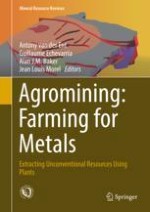This is the first book on global agromining/phytomining technology. It presents the complete metal farming or agromining chain; an emerging technology expected to be transformative in the extraction of resources of those elements not accessible by traditional mining techniques. Meeting the demand for critical minerals (rare earth elements, platinum group elements, nickel cobalt) is increasingly difficult in the 21st century due to resource depletion and geopolitical factors. Agromining uses hyperaccumulator plants as “metal crops” farmed on sub-economic soils or mineral waste to obtain valuable elements.
This book, which follows the metal farming chain, starts with the latest information on the global distribution and ecology of hyperaccumulator plants, biogeochemical pathways, the influence of rhizosphere microbes, as well as aspects of propagation and conservation of these unusual plants. It then presents the state of the art in new tools for identifying hyperaccumulator plants and for understanding their physiology and molecular biology. It goes on to describe the agronomy of “metal crops,” and opportunities for incorporating agromining into rehabilitation and mine closure, including test-cases of nickel, cobalt, selenium, thallium, rare earth elements and PGEs. Finally, it concludes with an overview of the latest developments in the processing of bio-ores and associated products.
This book is edited and authored by the pioneers in the field who have been at the foreground of the development of agromining over the past three decades. It is timely as agromining is now at a pivotal point in its development with rapid expansion of activities in the field around the globe. As such it is of interest to environmental professionals in the minerals industry, government regulators and academics.
